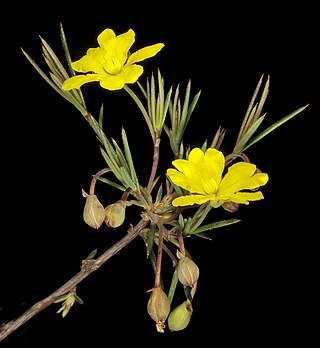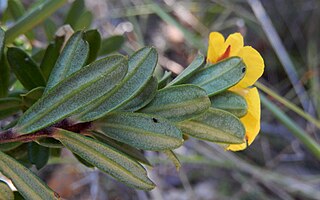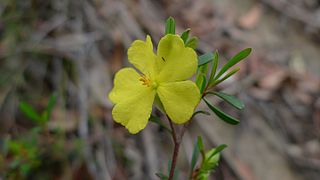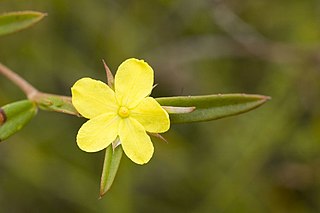
Hibbertia sericea, commonly known as silky guinea-flower, is a species of flowering plant in the family Dilleniaceae and is endemic to south-eastern Australia. It is an erect or spreading shrub with softly-hairy branches, elliptic to egg-shaped leaves with the narrower end towards the base, and yellow flowers with eight to fourteen stamens in a cluster on one side of two hairy carpels.

Hibbertia aspera, commonly known as rough guinea flower, is a species of flowering plant in the family Dilleniaceae and is endemic to eastern Australia. It is an ascending or erect shrub with low-lying or scrambling branches, oblong to lance-shaped or egg-shaped leaves with the narrower end towards the base, and yellow flowers with four to six stamens in a single group, joined at the base.

Hibbertia empetrifolia, commonly known as trailing guinea-flower, is a species of flowering plant in the family Dilleniaceae and is endemic to south-eastern Australia. It is a low-lying to spreading shrub with wiry stems, oblong to lance-shaped leaves with the narrower end towards the base, and pale to bright yellow flowers arranged on the ends of branchlets, with five to nine stamens arranged on one side of the two carpels.

Hibbertia obtusifolia, commonly known as hoary guinea flower, is a species of flowering plant in the family Dilleniaceae and is endemic to south-eastern Australia. It is usually an erect shrub with spreading branches, lance-shaped to egg-shaped leaves with the narrower end towards the base, and yellow flowers with thirty or more stamens arranged around three glabrous carpels.

Hibbertia pedunculata, commonly known as stalked guinea-flower, is a species of flowering plant in the family Dilleniaceae and is endemic to New South Wales. It is a diffuse, prostrate or erect shrub with linear leaves and yellow flowers borne on a relatively long peduncle, the flowers with fifteen to twenty stamens arranged around two hairy carpels.

Hibbertia fasciculata is a species of flowering plant in the family Dilleniaceae and is endemic to south-eastern Australia. It is a small erect to spreading shrub with glabrous stems except on new growth, narrow linear leaves, and yellow flowers arranged in leaf axils, with eight to twelve stamens surrounding three carpels.

Hibbertia riparia, commonly known as erect guinea-flower, is a species of flowering plant in the family Dilleniaceae and is endemic to the south-eastern Australia. It is an erect to spreading shrub with hairy foliage, linear leaves and yellow flowers with six to sixteen stamens in a single cluster on one side of two carpels.

Hibbertia hermanniifolia is a species of flowering plant in the family Dilleniaceae and is endemic to eastern Australia. It is an erect shrub with spatula-shaped to wedge-shaped leaves and yellow flowers arranged singly in leaf axils, with ten to fifteen stamens arranged around two hairy carpels.

Hibbertia acerosa, commonly known as needle leaved guinea flower, is a species of flowering plant in the family Dilleniaceae and is endemic to the south-west of Western Australia. It is a low, spreading or ascending shrub typically growing to a height of 10–60 cm (3.9–23.6 in) and has yellow flowers from July to December or from January to February.

Hibbertia bracteata is a species of flowering plant, in the family Dilleniaceae, and is endemic to eastern New South Wales. It is a shrub with lance-shaped to oblong leaves and yellow flowers with about sixteen stamens arranged on one side of the two carpels.

Hibbertia diffusa, commonly known as wedge guinea flower, is a species of flowering plant in the family Dilleniaceae and is endemic to south-eastern Australia. It is a prostrate to low-lying shrub with glabrous stems, egg-shaped to lance-shaped leaves with the narrower end towards the base, and bright yellow flowers arranged on the ends of branchlets, with twenty to twenty-five stamens arranged around two or three carpels.

Hibbertia calycina, commonly known as the lesser guinea flower, is a species of flowering plant in the family Dilleniaceae and is endemic to south-eastern Australia. It is a small shrub with linear leaves and yellow flowers with eight to eighteen stamens in a single cluster on one side of the two carpels.
Hibbertia dealbata is a species of flowering plant in the family Dilleniaceae and is endemic to northern Australia. It is an erect shrub that typically grows to a height of up to 2 m. It is similar to Hibbertia brownii but has lance-shaped to egg-shaped leaves with the lower end towards the base and flattened hairs on the lower surface. The flowers are arranged on the ends of the branchlets.
Hibbertia intermedia is a species of flowering plant in the family Dilleniaceae and is endemic to New South Wales. It is a small shrublet with linear to narrow oblong leaves and yellow flowers usually with seven to nine stamens arranged in a single cluster.

Hibbertia linearis is a species of flowering plant in the family Dilleniaceae and is endemic to eastern Australia. It is a shrub with linear to oblong or egg-shaped leaves and yellow flowers with 15 to 25 stamens arranged around the three carpels.

Hibbertia monogyna is a species of flowering plant in the family Dilleniaceae and is endemic to south-eastern Australia. It is an erect, mostly glabrous shrub with linear to wedge-shaped or spatula-shaped leaves and yellow flowers with ten to twelve stamens arranged around a single glabrous carpel.
Hibbertia nitida is a species of flowering plant in the family Dilleniaceae and is endemic to the Central Coast of New South Wales. It is an erect shrub with lance-shaped leaves with the narrower end towards the base and yellow flowers with about eleven stamens arranged on one side of two silky-hairy carpels.

Hibbertia procumbens, commonly known as spreading guinea flower, is a species of flowering plant in the family Dilleniaceae and is endemic to south-eastern Australia. It is a prostrate, often mat-forming shrub with more or less glabrous stems, linear to narrow lance-shaped leaves with the narrower end towards the base, and yellow flowers with eighteen to twenty-five stamens arranged in groups around usually four glabrous carpels.

Hibbertia salicifolia is a species of flowering plant in the family Dilleniaceae and is endemic to eastern Australia. It is a shrub with loose reddish bark, linear to oblong leaves and yellow flowers with the stamens arranged all around the carpels.

Hibbertia virgata, commonly known as twiggy guinea flower, is a species of flowering plant in the family Dilleniaceae and is endemic to south-eastern Australia. It is an erect shrub with linear leaves and yellow flowers with ten to twelve stamens arranged around three glabrous carpels.


















